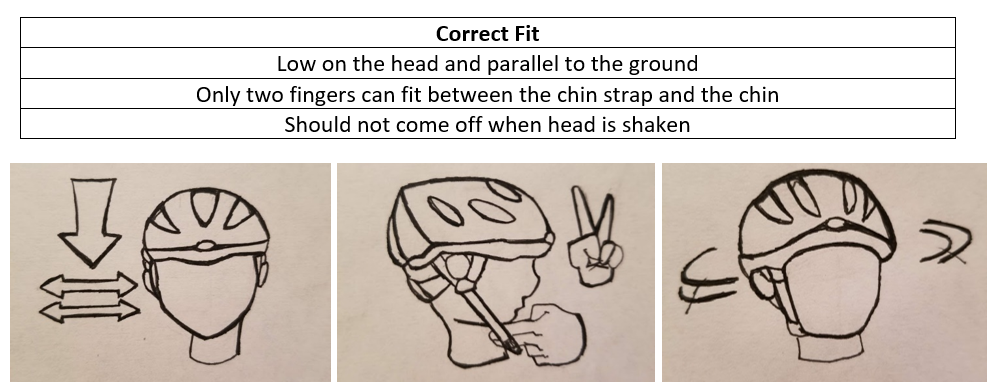Heads Up On Head Protection: Bicycle Helmets
Dr. Stephanie Bland and Dr. Elizabeth Lehto
Summer is officially here and full of fun and games…until it isn’t! Biking, skateboarding, rollerblading, and a variety of other outdoor activities peak this time of year when school is out of session and the weather becomes warm. Kids will inevitably fall, tumble, and bump their heads…all part of learning and development. In fact, even the most experienced rider is at risk for a fall! Without a helmet these summertime fun activities pose serious danger for traumatic brain injury which can lead to permanent disability, coma, or even death.
Physical activity is essential for the mental and physical wellbeing of children and adults. However, lack of protective headwear while partaking in high-risk activities leaves the threat of serious injury. According to the National Safety Council, helmets reduce the risk of head injury by more than 50% and the protective benefit for serious injuries is even higher.¹ Despite this, less half than children and adults report wearing helmets while riding.²
Obtaining a properly fitted helmet is the first step to protecting kids and adults from brain injury. Helmets work by absorbing energy and dissipating impact force over a larger area for a slightly longer time.³
If the force is not extreme and the helmet is intact and worn correctly, the brain should be protected from injury.
Step 1: Getting fit for a proper helmet:
Helmets come in four different sizes and models fit slightly differently, so it is important (especially for kids) to try on several sizes and models to find the best fit.³
A correctly fitting helmet should:
Sit low on the head and be parallel to the ground when the head is held upright. The person wearing the helmet should be able to see the lower brim when looking all the way up.
The chin strap should be snug with room for only two fingers between the strap and the chin.
When in place with the chin strap secure, the helmet should not come off or shift over the eyes when the person wearing it tries to shake it loose
Helmets should be replaced every 5 years, or if involved in a fall (even if there is no visible damage).³
Step 2: Make it a habit
The next most important step after ensuring helmet fits properly, is ensuring the helmet is consistently worn every time someone takes a ride. Barriers to use include being uncomfortable, lack of access to helmets, and lack of knowledge regarding importance of helmet use.²
What are the laws?
The promotion of an all-ages bicycle helmet law is a fundamental preventative strategy for increasing helmet use and reducing major bicycle related head trauma.²,⁴
There are 22 states (including the District of Columbia) that have statewide laws and more than 201 local ordinances, mostly focusing on children under age 18.5 There is currently no federal law requiring helmets.
In Kentucky, local regulations require children under 18 to wear a helmet when bicycling in any Louisville Metro Park. There is no statewide regulation regarding helmets.
Legislative effectiveness is enhanced when combined with supportive publicity and education campaigns. Norton Children’s provides excellent resources for families and caregivers on the proper selection and fit of protective headwear. In addition, there are many locations around the city of Louisville at Norton Children’s Medical Group offices where discounted headwear can be obtained if financial strain is prohibiting your family from having helmets available to the children.
Call to Action:
If you have been inspired by this post, here are some suggestions for improving use of helmets in your patient population.
Screen and encourage helmet use during visits
It is recommended that all bicyclists should wear properly fitting bicycle or multisport helmet each time they ride including young children who ride as passengers
Remind families that any helmet involved in a crash or otherwise damaged should be replaced, and that helmets should be replaced every 5 years or sooner if the manufacturer recommends it
Parents should be encouraged to wear a helmet both for their own safety and to model safe behavior for their children
Promote proper use of helmets through posters or pamphlets in the office
Establish or support community-based or school-based education programs to promote bicycle safety training that emphasizes helmet use
Become familiar with local laws and advocate at the local and state level to mandate helmet use by all bicyclists
Urge the media, such as local news stations and papers, when showing bicyclists to depict them wearing a helmet
Stephanie Bland, D.O.
University of Louisville | UL · Department of Pediatrics | Doctor of Pediatric Emergency Medicine
Dr. Stephanie Bland is a Third Year Pediatric Resident at the University of Louisville. She attended the University of Central Florida in Orlando, Florida for undergrad and completed medical school at the Edward via College of Osteopathic Medicine in Spartanburg, South Carolina.
Elizabeth Lehto, D.O.
University of Louisville | UL · Department of Pediatrics | Doctor of Pediatric Emergency Medicine
Dr. Elizabeth Lehto is a Pediatric Emergency Medicine Attending at Norton Womens and Children’s Hospital. Dr. Lehto attended Midwestern University Arizona College of Osteopathic Medicine and completed her residency and fellowship at the University of Louisville.
References
NSC. Bicycle Safety Statistics May Surprise You. 2019; https://www.nsc.org/safety-first-blog/bicycle-safety-statistics-may-surprise-you.
Scott LR, Bazargan-Hejazi S, Shirazi A, et al. Helmet use and bicycle-related trauma injury outcomes. Brain Inj. 2019;33(13-14):1597-1601.
Committe on Injury and Poison Prevention. Bicycle Helmets. Pediatrics. 2001;108(4):1030-1032.
Karkhaneh M, Kalenga JC, Hagel BE, Rowe BH. Effectiveness of bicycle helmet legislation to increase helmet use: a systematic review. Inj Prev. 2006;12(2):76-82.
Bicycle Helmet Safety Institute. Bicycle Helmet Laws. 2020; https://helmets.org/mandator.htm. Accessed 10/5/2020.






